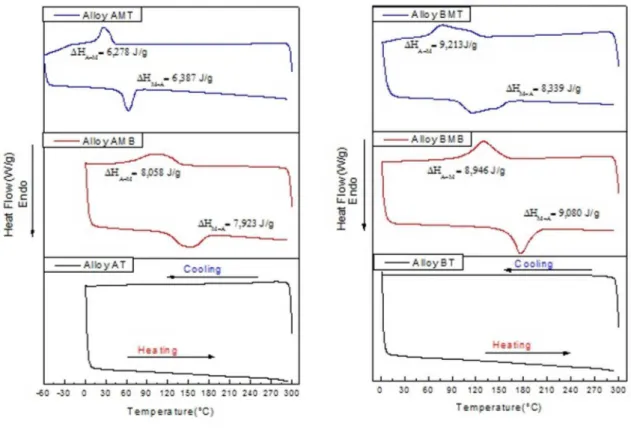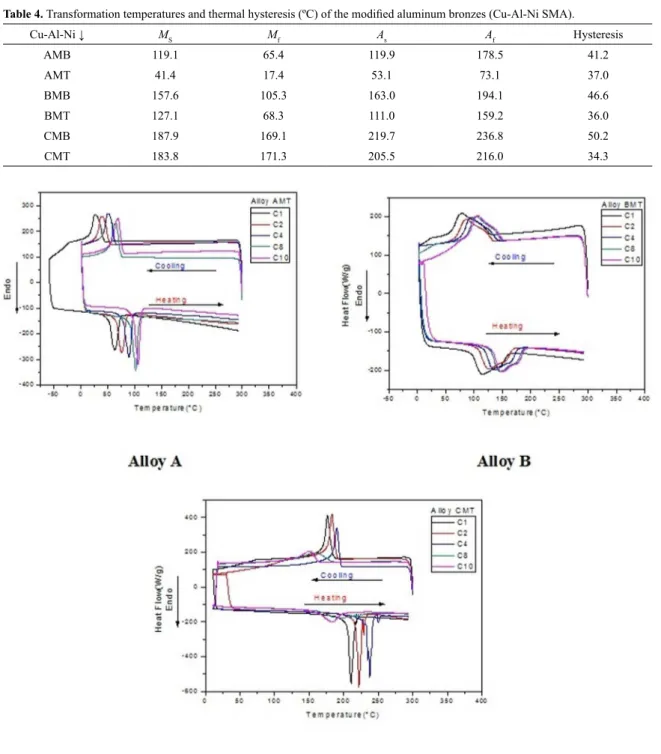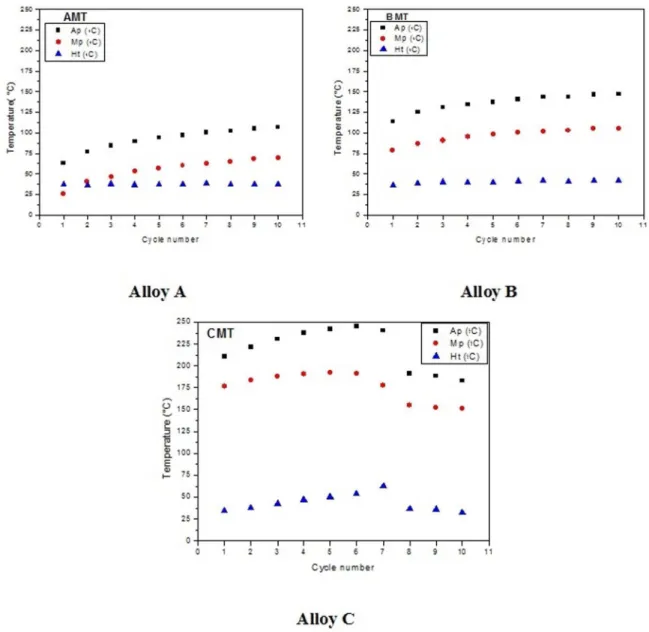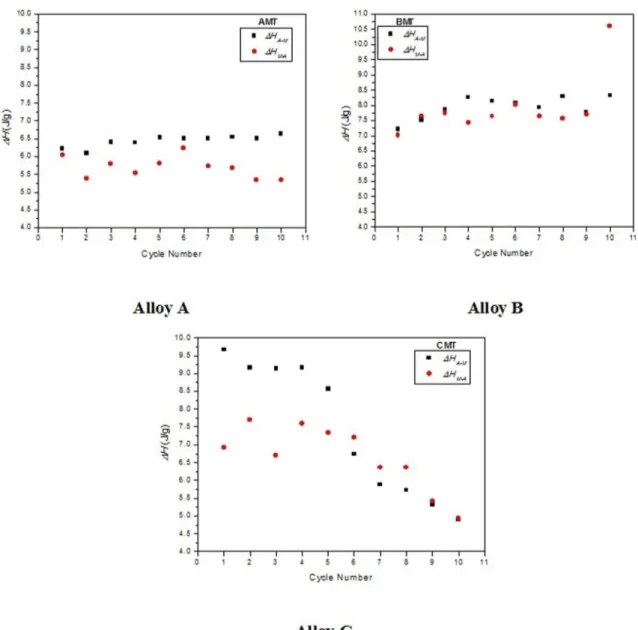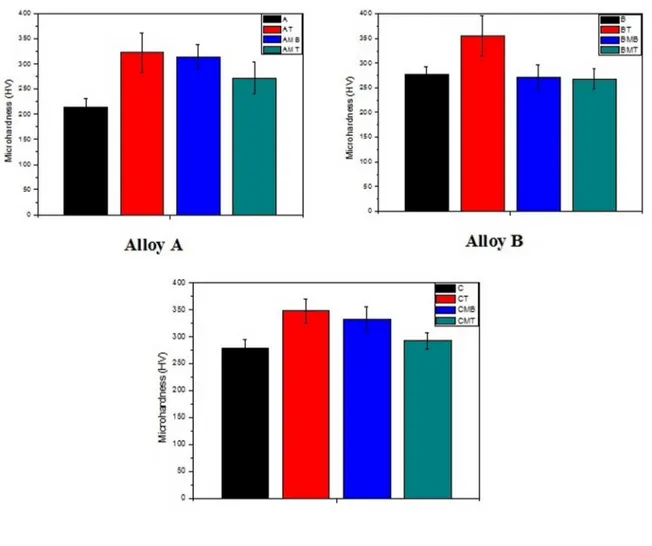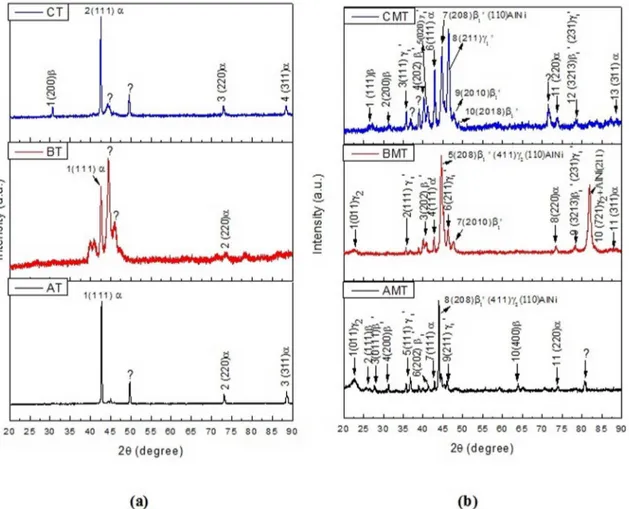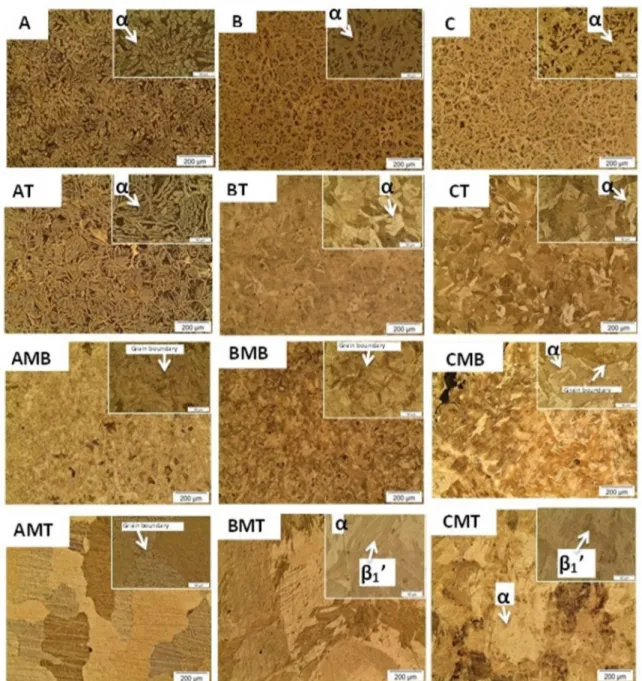Analysis of Compositional Modiication of Commercial Aluminum Bronzes to Obtain
Functional Shape Memory Properties
Aylanna Priscila Marques de Araujoa*, Jackson de Brito Simõesb, Carlos José de Araújoc
Received: December 12, 2016; Revised: July 17, 2017; Accepted: July 21, 2017
In copper-based shape memory alloys (SMAs), some exceptional phenomena, such as the shape
memory efect (SME) or superelasticity (SE), are observable. However, commercial aluminum bronzes,
Cu3Al-based alloys, do not present these functional properties (SME and/or SE) in their original state. Thus, since one of the main copper-based SMA systems is the Cu-Al-Ni alloy, this paper aims to
analyze the modiication of these commercial aluminum bronzes to SMA by the addition small amounts of Cu, Al and/or Ni. These modiied bronzes were reprocessed by induction melting and injected by centrifugation into a ceramic coating mold. The modiications were made to determine the nominal composition for a Cu-13,0Al-4,0Ni (%wt) SMA. The efectiveness of the modiications was veriied by diferential scanning calorimetry (DSC) thermal analysis. All modiied Cu-Al-Ni bronzes presented DSC peaks of the thermoelastic martensitic phase transformation, showing that SMA behavior was achieved, while the non-modiied bronzes revealed no transformation. These results were supported by Vickers hardness (HV), X-ray difraction (XRD), semi quantitative composition by EDS analysis and optical microscopy.
Keywords: Bronze, Shape memory alloys, Cu-Al-Ni alloys, Thermoelastic martensitic phase transformation.
*e-mail: aylannapriscila@hotmail.com
1. Introduction
Shape memory alloys (SMAs) are special metallic materials that present the functional phenomena of the shape
memory efect (SME) and superelasticity (SE); thus, they are classiied as active or smart metals. Both phenomena occur due to the thermoelastic martensitic phase transformation. The SMA undergoes a reversible martensitic transformation, allowing deformation through a twinning mechanism when temperatures are below the inal martensite transformation
limit (Mf)1. For the SME, this deformation is reversed when the detwinned structure (martensite) transforms to a parent
phase above the initial austenite transformation temperature (As) through heating. Cu-Al binary alloys show a martensitic
transformation with high transformation temperatures. However, these temperatures can be adjusted by adding a third element to the alloy. The addition of up to 4 %wt.
nickel reduces the transformation temperatures of Cu-Al alloys1,2. The nickel acts to retard the difusion of aluminum in annealed Cu-Al alloys, eliminating the stable γ2 phase that does not undergo the martensitic transformation. It is also known that the transformation temperatures of these
alloys are sensitive to their chemical composition1-4. For the Cu-XAl-4Ni alloys (% wt), it has been observed that the transformation temperatures abruptly decrease with a slight increase in Al content (X)1,5; depending on the Al content, diferent martensites can be formed, denoted as γ1' or β1'
3,6.
Copper-based SMA have steadily attracted the attention
of researchers during recent decades due to their low cost and ease of manufacturing when compared with TiNi - based
alloys1,4. From this knowledge and noting that commercial aluminum bronzes are basically Cu3Al - based alloys that have a number of other trace elements (Ni, Fe, Mn and others) in
their composition7, the aim of this study was to investigate whether these bronzes can present a phase transformation in the as supplied state after quenching. If not, thus study sought to assess the possibility of minimally altering its
chemical composition for the thermoelastic martensitic
transformation to occur, which is the origin of the functional SME phenomena.
It is important to note that an attempt to modify commercial
aluminum bronzes to obtain properties of the thermoelastic phase transformation and the shape memory efect has not been found in the international literature.
aDepartmento of Materials Engineering, Universidade Federal de Campina Grande, Av. Aprígio Veloso,
882, CEP 58429-140, Campina Grande, PB, Brazil.
bUniversidade Federal Rural do Semi-Árido, RN 233, km 01, Sítio Esperança II Zona rural, CEP
59780-000, Caraúbas, RN, Brazil.
cDepartment of Mechanical Engineering, Universidade Federal de Campina Grande, Av. Aprígio
2. Materials and Methods
2.1 Materials
The materials used in this study were three commercial aluminum bronze alloys supplied by Metals Luna Company (São Paulo, Brazil): BRONZE AL NI CA 9581 C95800; BRONZE SAE 630 C63000 and BRONZE SAE 68D C95500. Due to the lack of identiication, these bronzes were named A, B and C, respectively.
2.2 Methods
Initially, the supplied aluminum bronzes were subjected to a heat treatment at 850°C for 30 minutes, followed by quenching in water at approximately 30°C. After this treatment, the aluminum bronzes were cut into samples of a mass between 20 and 100 mg to be investigated in the DSC thermal analysis using a Q20 model calorimeter (TA Instruments). As these irst DSC analyzes did not reveal the
occurrence of phase transformation peaks, the samples of
each kind of bronze were subjected to a chemical analysis using energy dispersive spectroscopy (EDS) in a scanning electron microscope (SEM) VEGA3 model (Tescan) equipped with an EDS detector from Oxford Instruments (Oxford Instruments, X-act model). The magniication used was set at 2000x, and a total of 5 EDS measurements were taken at 5 random points for each sample. The compositions of the aluminum bronzes (as supplied) by weight (%wt.) from the EDS are summarized in Table 1.
According to this preliminary composition analysis for each bronze alloy, the new set of modiied bronzes for an SMA nominal composition of Cu-13,0Al-4,0Ni (%wt.)
was established based on the literature data1,5. For this, considering that the total mass to produce the new Cu-Al-Ni SMA specimens was 40 g, a mass correction of the elements for each of the as received bronze alloys (A, B and C) was performed, as shown in Table 2. The complementary elements for the production of modiied bronzes (Cu-Al-Ni SMA) were cut according to the calculated masses shown in Table 2.
The modiied bronzes were produced using the Powercast 1700 machine, from EDG equipment and controls (São Paulo, Brazil), which uses the induction melting technique with injection by centrifugation into a ceramic mold. At the end of the melting and injection process, the ceramic mold is removed from the machine and rapidly cooled in water. Once cleaned and prepared, samples were subjected to a heat treatment at 850°C for 30 minutes (betatization) followed by quenching in room temperature water. A speciic nomenclature was given to identify the new modiied aluminum bronze alloys, which can be seen in Table 3.
All modiied aluminum bronzes were irst characterized by DSC thermal analysis using the same equipment aforementioned (calorimeter Q20 model from TA Instruments). The sample masses for these analyses were between 20 and 100 mg, and the temperature range was from 0°C to 300°C with a heating/ cooling rate of 20°C/min under a nitrogen atmosphere. The starting and inal transformation temperatures, both during cooling and heating, were obtained by the tangent intersection
method of the DSC peaks1.
Vickers hardness (HV) measurements were carried out using a FM-700 equipment from Future-Tech. All indentations were performed at room temperature with a load of 300 gf and an application time of 15 s. One sample of each bronze
Table 1. Chemical composition (%wt.) of the as received commercial aluminum bronzes obtained by EDS.
Bronze ↓ Cu Al Ni Fe Mn Si Zn
A 69.45 7.55 3.71 14.18 1.28 12.83 1.48
B 72.95 9.64 6.16 7.15 0.97 -- 12.83
C 78.39 11.43 5.42 3.32 0.74 0.48 12.83
Table 2. Correction for the compositional aluminum bronzes A, B and C with a total mass of 40 g and the Cu-13.0Al-4.0Ni SMA. Bronze ↓ As received bronze (g) Cu added (g) Al added (g) Ni added (g)
A 37.5 -- 2.381 0.212
B 26.0 11.341 2.699
--C 30.0 8.795 1.856
--Table 3. Nomenclature used for bronze alloy modiied during execution of the work.
Conditions of the Bronze Alloy A B C
As received A B C
As received and quenched AT BT CT
As modiied AMB BMB CMB
(both the as supplied and for modiied) was used, and each sample was subjected to 10 indentations in random points.
For the identiication of the phases present in the aluminum bronzes, the XRD technique was employed using a difractometer XRD-6000 Model from Shimadzu.
The Cu-Kα radiation was used with a 2Ө interval from 20
to 90° and scanning steps of 0.02° with 3 s of accumulation. The microstructures were observed by optical microscopy (OM). The etching solution used for these observations was 10 g FeCl3 + 25 mL HCl + 100 mL H2O. The images were captured using an Olympus microscope, model BX51M.
3. Results and Discussion
3.1 Veriication of phase transformation by
Diferential Scanning Calorimetry (DSC)
DSC analyses were performed for the aluminum bronze alloys under the following conditions: supplied after quenching (AT, BT and CT), modiied with no heat treatment (AMB, BMB and CMB) and modiied after quenching (AMT, BMT and CMT).
It can be observed from the DSC results shown in Figure 1 that all supplied bronzes showed no phase transformation, even after the heat treatment (quenching). On the other hand, all modiied alloys in both conditions (no quenching and after quenching) provided phase transformation peaks.
The occurrence of the thermoelastic martensitic phase
transformation in all modiied bronzes reveal a strong potential for the shape memory efect to be achieved.
Figure 1 also shows that the temperatures of the forward (cooling, Ms and Mf) and reverse (heating, As and Af)
transformations have been reduced for all modiied bronze alloys after quenching, which is now denoted Cu-Al-Ni SMA. The forward (during cooling) and reverse (during heating) phase transformation temperatures were measured with the method of tangents in the transformation peaks1. Table 4 summarizes these phase transformation temperatures of the new Cu-Al-Ni SMA with no heat treatment and after quenching. It is veriied that the transformation temperatures decrease with the increase of the aluminum content in the modiied bronzes (Cu-Al-Ni SMA), according to the literature1,5. By checking Tables 4 and 5, it is noted that the Ms temperature
is reduced from 183.8°C in the CMT alloy (9.7 %wt. Al) to only 41.4°C in the AMT alloy (17.0 %wt. Al). According to Chang5, thermal transformation of the Cu-13,0Al-4,0Ni (%wt.) SMA occurs between 150°C and 210°C, with a Ms
temperature on the order of 181°C.
Ten thermal cycles were performed to verify the stability of the phase transformations observed in the new Cu-Al-Ni SMA manufactured in this study. Figure 2 shows the DSC
curves for alloys A, B and C (modiied and before and after quenching) during the thermal cycling. For the three alloys, well-deined peaks are again observed, conirming the forward (cooling) and reverse (heating) martensitic transformation. The transformation temperatures shifted at each cycle to higher temperatures for alloys A and B. It is well known that thermal cycling up to 200°C may promote not only modiications in the alloy structure and composition but also changes in its
physical and mechanical properties1,6. Araujo et al.8 detected
an increase in the critical transformation temperatures
associated with a change of γ1’ into β1’ martensite after a suiciently long aging time at 200°C. In our case, and only for alloy C, after an increase during the irst seven thermal cycles, the transformation temperatures shifted to lower values. The enthalpies of transformation also decreased, indicating that the phase transformation for this particular alloy tends to disappear with thermal cycling between 0°C and 300°C. This is caused by the fact that the modiied alloy C presents the highest transformation temperatures As and Af
between 200°C and 250°C. This behavior was also observed for the Cu-Al-Nb SMA, where after the ifth thermal cycle, at temperatures higher than 250°C, the phase transformation tends to disappear completely. The low thermal stability
observed in the alloys of the Cu-Al-Nb system is due to
intense development of the difusion processes at relatively high temperatures of the cycled heating9. This is probably
the case for our modiied alloy C (CMT). However, after disappearance after a few cycles to a maximum temperature of 300°C, the phase transformation can be recovered by a new heat treatement (quenching), so that the material (Cu-Al based SMA) can be reused for a few more thermal cycles.
The aforementioned variation in the transformation
temperatures for alloys A, B and C in the modiied and quenched condition can be best seen in Figure 3. An increase of the peak temperatures was observed for both the forward
(Mp) and reverse transformation (Ap), as well as the stability of the thermal hysteresis behavior (Ht = Ap-Mp) during the
cycling, except for alloy C beginning at the eighth cycle, as previously described.
The behavior of the forward (ΔHA-M) and reverse (ΔHM-A)
transformation enthalpies (in J/g) can be seen in Figure 4. For the modiied alloys AMT and BMT, a slight diference between the forward and reverse transformations was observed. Moreover, neither enthalpies are practically afected by the number of cycles. This is an apparent indication that the alloy thermodynamic states are not inluenced by either the
direction of transformation or the number of thermal cycles,
Table 4. Transformation temperatures and thermal hysteresis (ºC) of the modiied aluminum bronzes (Cu-Al-Ni SMA).
Cu-Al-Ni ↓ MS Mf As Af Hysteresis
AMB 119.1 65.4 119.9 178.5 41.2
AMT 41.4 17.4 53.1 73.1 37.0
BMB 157.6 105.3 163.0 194.1 46.6
BMT 127.1 68.3 111.0 159.2 36.0
CMB 187.9 169.1 219.7 236.8 50.2
CMT 183.8 171.3 205.5 216.0 34.3
Figure 2. Efects of thermal cycling on the Cu-Al-Ni SMA (modiied and quenched).
at relatively high temperatures of cycled heating9. For all
the modiied alloys, it was found that these energies agree with the transformation enthalpies reported in the literature for Cu-Al-Ni SMA with 13.5 to 14.0 %wt. Al in the range of 5 to 10 J/g1,5,6.
3.2 Mechanical Behavior - Hardness HV
Figure 5 shows the hardness HV values for the aluminum bronze alloys in all studied conditions (as supplied, as supplied
Figure 3. Evolution of the peak temperatures of the transformations and hysteresis during thermal cycling of the Cu-Al-Ni alloys (modiied and quenched).
the twinned martensite phase after quenching (γ1’ and β1’ martensites). This level of hardness for the thermoelastic martensitic structure, from approximately 270 HV to 300 HV, is in agreement with values found earlier in the literature
for the same Cu-Al-Ni SMA11.
3.3 X-Ray Difraction (XRD)
Figure 6 shows XRD patterns obtained at room temperature for the as supplied (Fig. 6a) and modiied (Fig. 6b) bronzes, both annealed and quenched. The identiication of the XRD peaks was performed based on the literature values for
Cu-Al-Ni SMA3,12. In Figure 6(a) for the three alloys, the
Figure 4. Evolution of the transformation enthalpies during thermal cycling of the of the Cu-Al-Ni alloys (modiied and quenched).
Cu-Al-Ni SMA. The deformation of the two-phase domain is impractical due the fragility that the γ2 phase produces, caused by its inconsistency with the matrix1. There is also
evidence of another possible precipitate that these alloys may
present: the AlNi, which has a B2 ordered type structure12. As the martensitic phase type β1' is less stable than γ1', the thermal cycling may cause the alloy that contains a higher volume of this phase to lose its SME properties. This occurs due to structural changes and dislocation arrangements at quenching sites that function as seeds for nucleation of the orthorhombic martensite phase β1'
3.
3.4 Energy Dispersive Spectroscopy (EDS)
The semi-quantitative evaluation of the chemical composition of the modiied and quenched aluminum bronze alloys (AMT,
BMT and CMT) was obtained by EDS microanalysis carried out in dots and lines. The measurements were statistically treated to obtain the average values, as summarized in Table 5. These values show that the alloys are not identical in composition, as they present diferent contents of Cu and Al. From these results, it is possible to understand the
behavior of the phase transformation temperatures obtained
by the DSC for each modiied bronze, considering that with the increasing aluminum content, the transformation
temperatures decrease1,8. This also may explain the occurrence
Figure 5. Microhardness values of the studied Cu-Al-Ni alloys.
a correlation to the designed alloy (nominal composition
of Cu-13,0Al-4,0Ni SMA), the aluminum content values
presented the opposite behavior. Additionally, it should be noted that the reprocessing with the investment casting technique alters the content of the residual elements (Fe, Mn, Si and Zn). The EDS results of the modiied and quenched bronzes were statistically compared by a one-way ANOVA. P-values of less than α=0.05, as shown in Table 6, indicate signiicant diferences between the content values of the main elements (Al, Cu and Ni).
It is important to note that these aluminum bronzes may have other residual elements, such as Fe and Si7,10. In our case, a signiicant Zn content was also detected (Table 1). In the case of bronze B, the analysis by EDS did not detect the presence of Si, perhaps because it is a semi quantitative technique. After modifying the bronzes by remelting with addition of new amounts of Cu, Al and/or Ni, the compositions
undergo a complete rearrangement, including the residual elements Fe, Mn, Si and Zn, as indicated in Table 5. The Zn content is reduced and even disappears in the case of alloy B. This may occur by evaporation of Zn during the modiication process which includes a further melting of the bronze. Si appearing in alloy B after modiication may be associated with the limitation of the EDS technique on detecting it in the original bronze (alloy B, Table 1).
3.5 Optical Microscopy (OM)
Figure 7 shows the optical micrographs of the studied bronze alloys. The A, B and C alloys present large quantities of the α phase, which is characteristic of aluminum bronzes. This phase is a solid copper-based solution having a CFC structure and formed when the cooling time is suicient for the occurrence of the phases, according to the phase diagram
Figure 6. X-ray difractograms of the studied Ni alloys. (a) Quenched bronzes (as provided). (b) Modiied and quenched Cu-Al-Ni alloys.
Table 5. Chemical composition (%wt.) obtained by EDS for the modiied and quenched aluminum bronzes.
Cu-Al-Ni ↓ Cu Al Ni Fe Mn Si Zn
AMT 73.7±0.30 17.0±0.62 4.9±0.21 2.2±0.04 0.7±0.01 0.6±0.27 0.8±0.06 BMT 79.2±0.87 14.2±0.77 3.3±0.01 2.5±0.02 0.5±0.00 0.3±0.09 --CMT 82.0±0.56 9.7±0.25 4.0±0.01 2.5±0.73 0.6±0.03 0.3±0.07 0.9±0.03
Table 6. Statistical comparison of the EDS results by a one-way ANOVA of the modiied and quenched aluminum bronzes (Cu-Al-Ni SMA).
Cu Al Ni
p-Value 0.004 0.001 0.02
the heat treatment of quenching promoted a thin plate shape for the α phase. Whereas for the BT and CT alloys, the microstructures presented coarser grains in the α phase domains. According to Rodrigues13, the α phase is ductile, and its reduction tends to increase the overall hardness. This fact was also observed through the microhardness analysis in this study. For the other alloys, the presence of
the α phase and discrete needles of the martensite β1' (with structure 18R) was observed on the matrix of the austenite β (with the ordinate structure DO3). Grain boundaries were observed for the quenched alloys, where possible acicular precipitates still appear scattered. According to Chang5, these precipitates can correspond to the γ2 phase, which has
Figure 7. Microstructures of all the studied non-modiied and modiied bronze alloys (Cu-Al-Ni SMA).
4. Conclusions
The possibility of commercial aluminum bronzes to
present the thermoelastic martensitic transformation and its
origin in shape memory phenomena was investigated in this work. It was observed that a small compositional modiication
in these commercial materials can promote the occurrence
of thermoelastic transformation, which was conirmed through a DSC thermal analysis. Modiied bronze alloys, now classiied as Cu-Al-Ni SMA, present Ms temperatures in the range of 40°C to 190°C, depending on the Al content. The hardness HV results showed that the modiied samples, before and after quenching, exhibit a lower hardness value than the as supplied bronzes (after quenching) due to the
5. Acknowledgements
The authors thank the National Council for Scientiic and Technological Development (CNPq) Brazilian oice for sponsoring the following projects: National Institute of Science and Technology for Smart Structures in Engineering (INCT-EIE, grant number 574001/2008-5), UFCG-UFRJ-ITA "Casadinho-Procad" (grant number 552199/2011-7), Universal 14/2012 (grant number 474524/2012-4) and PQ-1D (grant number 304658/2014-6).
6. References
1. Otsuka K, Wayman CM. Shape Memory Materials. 1st ed.
Cambridge: Cambridge University Press; 1998. 284 p. 2. Patoor E, Lagoudas DC, Entchev PB, Brinson LC, Gao X.
Shape memory alloys, Part I: General properties and modeling of single crystals. Mechanics of Materials.
2006;38(5-6):391-429.
3. Pereira EC, Matlakhova LA, Matlakhov AN, Araújo CJ, Shigue CY, Monteiro SN. Reversible martensite transformations in thermal cycled polycrystalline Cu-13.7%Al-4.0%Ni alloy.
Journal of Alloys and Compounds. 2016;688(Pt B):436-446.
4. Yang S, Zhang F, Wu J, Lu Y, Shi Z, Wang C, et al. Superelasticity and shape memory efect in Cu-Al-Mn-V shape memory alloys.
Materials & Design. 2017;115:17-25.
5. Chang SH. Inluence of chemical composition on the damping characteristics of Cu-Al-Ni shape memory alloys. Materials Chemistry and Physics. 2011;125(3):358-363.
6. Pereira EC, Matlakhova LA, Matlakhov AN, Shigue CY, Monteiro SN. Physical and Structural Characterization of a
Monocrystalline Cu-13.7Al-4.2Ni Alloy Subjected to Thermal Cycling Treatments. Metallurgical and Materials Transactions A. 2014;45(4):1866-1875.
7. Copper Development Association. Aluminium Bronze - Essential for Industry. CDA Publication Nº 86. Hemel Hempstead: Copper
Development Association; 1989. 16 p.
8. Araujo VEA, Gastien R, Zelaya E, Beiroa JI, Corro I, Sade M, et al. Efects on the martensitic transformations and the microstructure of CuAlNi single crystals after ageing at 473 K. Journal of Alloys and Compounds. 2015;64:155-161.
9. Lelatko J, Morawiec N, Koval YN, Kolomyttsev VI. Structure and properties of high-temperature alloys with the efect of shape memory in the system Cu-Al-Nb. Metal Science and Heat Treatment. 2009;41(8):351-353.
10. Lin G, Wang H, Wei Y, Zhang Z, Zhou K. Efects of heat treatments on microstructure and properties of nickel-aluminum bronze fabricated by centrifugal casting. Journal of Materials Research. 2016;31(24):3832-3840.
11. Silva NJ, Silva MM, Gomes AAC, Santos MA, Gonzalez CH, De Araujo CJ. Inluência do reprocessamento por plasma e da variação do tempo de tratamento térmico nas propriedades de uma liga Cu-Al-Ni com memória de forma. 17º CBECIMat - Congresso Brasileiro de Engenharia e Ciência dos Materiais. 2006 Nov 15-19; Foz do Iguaçu, PR, Brazil. p. 5264-5275
12. Chentouf SM, Bouabdallah M, Gachon JC, Patoor E, Sari A. Microstructural and thermodynamic study of hypoeutectoidal Cu-Al-Ni shape memory alloys. Journal of Alloys and Compounds.
2009;470(1):507-514.

